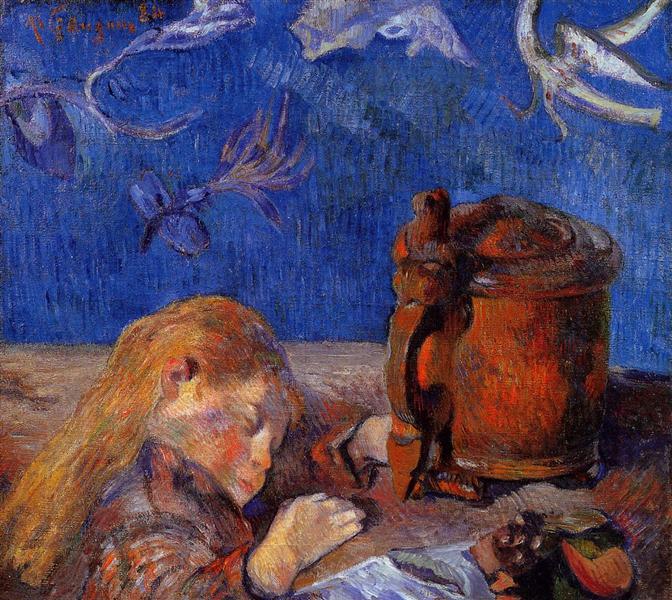Description
"Clovis Gauguin asleep" is a work by Paul Gauguin created in 1884, which offers an intimate and contemplative look at the artist's family life, particularly his relationship with his son, Clovis. In this painting, Gauguin shows his artistic maturity, marked by his growing interest in the exploration of the form and color, concepts that will be central to his subsequent work.
The composition of the painting is remarkable for its simplicity and its reassuring atmosphere. Clovis, lying on a background of soft yellow tones, is presented almost like a symbol of child peace. The child's position is relaxed, almost ethereal, which captures an ephemeral and deprived moment of family life. His face, barely delineated, evokes a feeling of innocence and tranquility. The environment, which consists of a uniform color background, invites the viewer to focus all his attention on the child, intensifying the emotional connection with the subject. This compositional choice, which was previously atypical, resonates in Gauguin's post -impressionist style, who was looking to get away from the usual complexities and conveniences of the painting of his time.
The use of color is a fundamental aspect in "Clovis Gauguin asleep." Gauguin uses a warm palette, dominated by yellow and brown, to create a sense of warmth and closeness. The soft light that surrounds the child transmits a serenity that is characteristic of Gauguin's work. In this painting, Color not only acts as an aesthetic vehicle, but also as an expressive medium that communicates the vulnerability of childhood. The atmosphere that creates suggests a harmony that contrasts with the tensions present in your personal life at that time.
It is interesting to consider the context in which this work was created. 1884 was a crucial year in the life of Gauguin, who began to distance himself from the world of academic art in Paris and to look for a more personal and symbolic voice. "Clovis Gauguin asleep" reflects this change in his life, by focusing on family and intimacy. In a period in which his artistic career began to flourish, the representation of his own son reveals not only his paternal love, but also the exploration of childhood purity, an issue that will resonate throughout his work.
The painting is part of the post -impressionist movement, which was characterized by a freer and more symbolic use of color and a search for emotional expression through form. This trend is palpable not only in “Clovis Gauguin asleep”, but also in other contemporary works of Gauguin, where color and shape become a means of communication of the internal and emotional world. paintings as "the vision after the sermon" or "Where do we come from? What are we? Where are we going? " They also explore the relationship between everyday and symbolic, but with a different complexity and scope.
By observing "Clovis Gauguin asleep", it is evident that this work encapsulates a stage of Gauguin's life marked by the mixture of tenderness and melancholy. Capture not only a child who sleeps, but also a moment of introspection in the life of a man who in his search for artistic truth, also finds a space for reflection on what it is to be a father. Ultimately, this simple and deeply moving portrait is an invitation to contemplation, underlining the ability of painting as a means to explore both the beauty of everyday life and the deepest emotions that accompany it. These qualities make “Clovis Gauguin asleep” a work not only of artistic interest, but also of emotional legacy within the rich tradition of modern art.
KUADROS ©, a famous paint on your wall.
Hand-made oil painting reproductions, with the quality of professional artists and the distinctive seal of KUADROS ©.
Reproduction service paintings With a guarantee of satisfaction. If you are not completely satisfied with the replica of your painting, we refund your money 100%.

